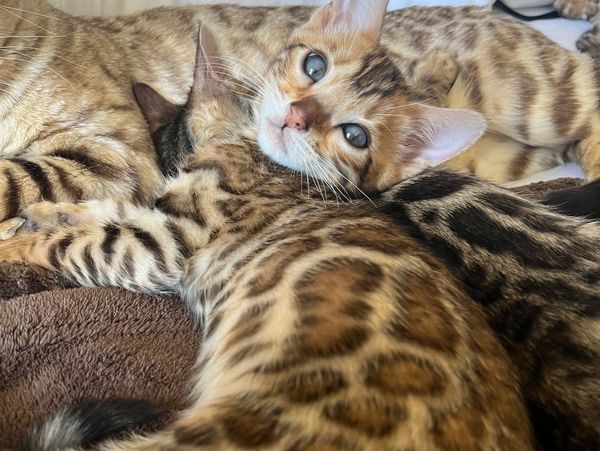frequently ASKED QUESTIONS

About the Breed
The Bengal cat’s history is as captivating as its appearance. The breed was developed in the 1960s by Jean Mill, a cat breeder in the United States who crossbred the Asian leopard cat, a small wild feline native to Asia, with domestic cats. Her goal was to create a breed that combined the exotic beauty of the leopard cat’s spotted coat with the friendly, social temperament of a house cat. Over the following decades, breeders refined the Bengal’s traits through selective breeding, ensuring they were fully domesticated while retaining their wild, striking looks. Officially recognized by The International Cat Association (TICA) in 1983, Bengals have since gained worldwide popularity for their unique combination of intelligence, playfulness, and affectionate nature. Today, they are celebrated as a breed that bridges the gap between the wild and domestic worlds, bringing a touch of the exotic into homes everywhere.

Are Bengal cat's high maintenance?
Bengal cats are not necessarily high maintenance, but they do have specific needs that potential owners should consider. Energy Levels and Stimulation Bengals are highly energetic and require plenty of physical and mental stimulation. They thrive in environments where they have access to climbing spaces, interactive toys, and regular playtime.
Social Interaction:
Bengals are social cats that enjoy spending time with their owners. They may not be content to be left alone for long periods and do best in homes where they can receive regular attention or have a companion, whether another pet or an involved owner.
Grooming Needs:
Despite their luxurious coats, Bengals are relatively low-maintenance in terms of grooming. They are minimal to no shedding, Their short, silky fur doesn’t mat easily, and weekly brushing is usually sufficient to keep their coat healthy and reduce shedding.

Are Bengal's Hypoallergenic?
Why Bengals Are Considered Hypoallergenic
Lower Fel d 1 Production:
Fel d 1 is a protein found in cat saliva, skin, and dander, and it’s the primary cause of cat allergies. Bengals
produce lower levels of Fel d 1 compared to some other breeds.
Low-Shedding Coat:
Bengals have a short, fine coat that sheds less than most cats, which means fewer allergens are spread in the home.
Easy Grooming:
Their sleek fur doesn’t require much maintenance, reducing the amount of dander released.

Personality and Behavior
What are Bengals like as pets?
Bengals are energetic, intelligent, and playful. They are very social and enjoy interacting with their owners. They can also be vocal and curious.
Do Bengals get along with other pets?
Yes, Bengals can get along with other cats and dogs, especially if introduced properly. They enjoy having a companion, but their high energy may overwhelm less active pets.
Are Bengals good with children?
Yes, Bengals are generally good with children, especially those who enjoy active and interactive play.
This website uses cookies.
We use cookies to analyze website traffic and optimize your website experience. By accepting our use of cookies, your data will be aggregated with all other user data.
